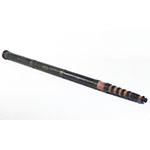Large terrestrial telescope consisting of ten wooden tubes covered with cardboard. The largest is additionally covered with green leather with gilt tooling and the Medici coat of arms. It houses the wooden mount for the objective lens. The other tubes are covered with red marbled paper. The smallest contains the compound eyepiece. The objective lens inv. 2587 and the compound eyepiece inv. 3449.2 belong to this telescope. The compound eyepiece inserted in the telescope carries the inscription "lente meno acuta" ["less acute (i.e., less powerful) lens"]. The tube in which it slides has two inscriptions: "Per la lente più acuta" ["for the more acute lens"] and "Lente meno acuta" ["(for) the less acute lens"]. The magnification is 223 or 112, depending on the eyepiece. Toward the mid-1660s, Giuseppe Campani built a telescope of 52 palms (11.6 m) that—in a paragone degli occhiali [one of several telescope competitions]—proved superior to one made by Eustachio Divini. In 1665, Campani presented another instrument of the same length to Grand Duke Ferdinand II de' Medici, which is the instrument here described. On July 11, 1665, the Grand Duke observed Jupiter and its moons.









